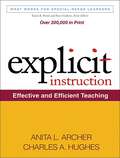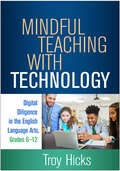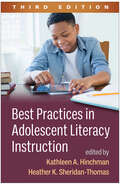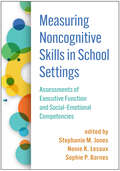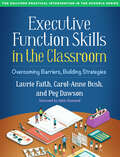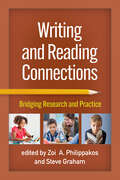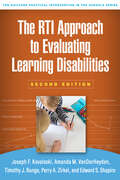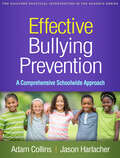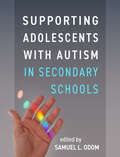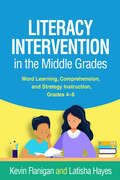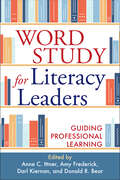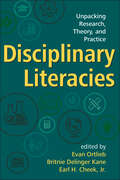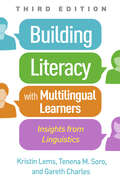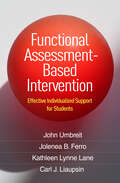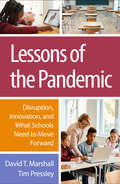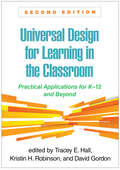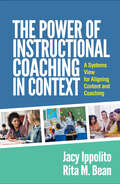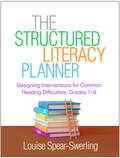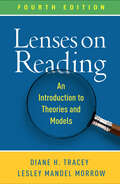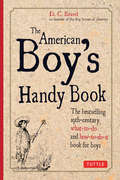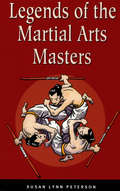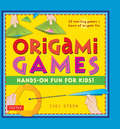- Table View
- List View
Explicit Instruction: Effective and Efficient Teaching (What Works for Special-Needs Learners)
by Anita L. Archer Charles A. HughesExplicit instruction is systematic, direct, engaging, and success oriented--and has been shown to promote achievement for all students. This highly practical and accessible resource gives special and general education teachers the tools to implement explicit instruction in any grade level or content area. The authors are leading experts who provide clear guidelines for identifying key concepts, skills, and routines to teach; designing and delivering effective lessons; and giving students opportunities to practice and master new material. Sample lesson plans, lively examples, and reproducible checklists and teacher worksheets enhance the utility of the volume. Purchasers can also download and print the reproducible materials for repeated use. Video clips demonstrating the approach in real classrooms are available at the authors' website: www.explicitinstruction.org. See also related DVDs from Anita Archer: Golden Principles of Explicit Instruction; Active Participation: Getting Them All Engaged, Elementary Level; and Active Participation: Getting Them All Engaged, Secondary Level
Mindful Teaching with Technology: Digital Diligence in the English Language Arts, Grades 6-12
by Troy HicksTechnology is integral to teaching in the English language arts, whether in-person, hybrid, or remote. In this indispensable guide, Troy Hicks shows how to teach and model "digital diligence"--an alert, intentional stance that helps both teachers and students use technology productively, ethically, and responsibly. Resources and lesson ideas are presented to build adolescents' skills for protecting online privacy, minimizing digital distraction, breaking through &“filter bubbles,&” fostering civil conversations, evaluating information on the Internet, creating meaningful digital writing, and deeply engaging with multimedia texts. Dozens of websites, apps, and other tools are reviewed, with links provided at the companion website; end-of-chapter teaching points and guiding questions facilitate learning and application.
Best Practices in Adolescent Literacy Instruction, Third Edition
by Kathleen A. Hinchman Heather K. Sheridan-Thomas Donna E. AlvermannWith 50% new material reflecting current research and pedagogical perspectives, this indispensable course text and teacher resource is now in a thoroughly revised third edition. Leading educators provide a comprehensive picture of reading, writing, and oral language instruction in grades 5–12. Chapters present effective practices for motivating adolescent learners, fostering comprehension of multiple types of texts, developing disciplinary literacies, engaging and celebrating students' sociocultural assets, and supporting English learners and struggling readers. Case examples, lesson-planning ideas, and end-of-chapter discussion questions and activities enhance the utility of the volume. New to This Edition *Chapters on new topics: building multicultural classrooms, Black girls&’ digital literacies, issues of equity and access, and creating inclusive writing communities. *New chapters on core topics: academic language, learning from multiple texts, and reading interventions. *Increased attention to issues of diversity, equity, and inclusion. *The latest knowledge about adolescents' in- and out-of-school literacies.
Measuring Noncognitive Skills in School Settings: Assessments of Executive Function and Social-Emotional Competencies
by Stephanie M. Jones, Nonie K. Lesaux and Sophie P. BarnesChildren's social–emotional and self-regulation skills are critical for success in school and, ultimately, in the workplace. How can educators determine the most effective approaches for measuring students' interpersonal competencies? And how can they use the data to improve their own practice? Relevant for school leaders, educators, researchers, and other stakeholders, this book brings together leading experts from multiple disciplines to discuss the current state of measurement and assessment of a broad range of noncognitive skills and present an array of innovative tools. Chapters describe measures targeting the individual student, classroom, whole school, and community; highlight implications for instructional decision making; examine key issues in methodology, practice, and policy; and share examples of systematic school- and districtwide implementation.
Executive Function Skills in the Classroom: Overcoming Barriers, Building Strategies (The Guilford Practical Intervention in the Schools Series)
by Laurie Faith Carol-Anne Bush Peg DawsonWith insight and humor, this motivating guide shows how to bring executive functions (EF) to the forefront in K–8 classrooms--without adopting a new curriculum or scripted program. Ideal for professional development, the book includes flexible, practical, research-based ideas for implementation in a variety of classroom contexts. It shares stories from dozens of expert teachers who are integrating explicit EF support across the school day. Provided is a clear approach for talking about EF barriers and strategies as part of instruction, and working as a class to problem-solve, explore, and apply the strategies that feel right for each student. Purchasers get access to a Web page where they can download and print several reproducible tools in a convenient 8 1/2" x 11" size. This book is in The Guilford Practical Intervention in the Schools Series, edited by Sandra M. Chafouleas.
Writing and Reading Connections: Bridging Research and Practice
by Zoi A. Philippakos Steve GrahamWriting skills are essential for success in the 21st-century school and workplace, but most classrooms devote far more time to reading instruction, with writing often addressed in isolation or excluded. In this insightful professional development resource and text, leading researchers discuss why and how to integrate writing and reading instruction in grades K–12 and beyond. Contributors explore how to harness writing–reading connections to support learning in such areas as phonics and spelling, vocabulary, understanding genre and text structure, and self-regulated strategy development, as well as across content areas and disciplines. Special considerations in teaching emergent bilingual students and struggling literacy learners are described. User-friendly features include guiding questions, classroom examples, and action questions that help teachers translate the research and concepts into practice.
The RTI Approach to Evaluating Learning Disabilities (The Guilford Practical Intervention in the Schools Series)
by Joseph F. Kovaleski Amanda M. VanDerHeyden Timothy J. Runge Perry A. Zirkel Edward S. ShapiroFrom leading authorities, this indispensable work is now in a revised and expanded second edition, presenting state-of-the-art tools and procedures for practitioners. The book shows how to use response to intervention (RTI) to evaluate K–12 students for specific learning disabilities (SLD). The second edition gives increased attention to optimizing the instructional environment in the context of a multi-tiered system of supports (MTSS). Procedures are described for screening at-risk students; using RTI to intensify instruction in reading, writing, and math; identifying SLD; determining eligibility for special education; and planning individualized education programs. Case examples and pointers for practice are woven throughout. In a convenient large-size format, the book includes reproducible tools that can be downloaded and printed for repeated use. New to This Edition *Incorporates contemporary perspectives on SLD, upgraded procedures for implementing an MTSS, new approaches to measuring RTI, and enhancements in using classroom observations. *Chapter on best practices in academic screening, including important dos and don'ts. *Separate chapters on using RTI for reading, written expression, and mathematics. *Chapter on RTI and special education law, focusing on what practitioners need to know. This book is in The Guilford Practical Intervention in the Schools Series, edited by Sandra M. Chafouleas.
Effective Bullying Prevention: A Comprehensive Schoolwide Approach (The Guilford Practical Intervention in the Schools Series)
by Adam Collins Jason HarlacherGoing beyond other bullying prevention resources, this book presents an approach grounded in evidence-based best practices, together with concrete guidance for weaving it sustainably into the fabric of a school. The authors describe a range of ways to support the development of prosocial skills in K–12 students, make data-based decisions to respond to bullying, and build partnerships across students, staff, and families. Of crucial importance, the book explains how to ensure that bullying prevention efforts are implemented with fidelity and do not fade away over time. An in-depth case study illustrates what effective implementation looks like in the school setting. The large-size format facilitates photocopying; reproducible tools to support implementation can be downloaded and printed for repeated use. This book is in The Guilford Practical Intervention in the Schools Series, edited by Sandra M. Chafouleas.
Supporting Adolescents with Autism in Secondary Schools
by Samuel L. OdomIn a convenient large-size format, this book presents the first research-based, comprehensive program designed to support high school students with autism spectrum disorder (ASD). Developed and tested in public schools by the Center on Secondary Education for Students with Autism Spectrum Disorder (CSESA), the program addresses four critical areas--literacy, social competence and peer relationships, independence, and postschool transition preparation for students and their families. Chapters provide a roadmap for implementation of each component, complete with intervention guidelines, case vignettes, key findings, lessons learned, and reproducible forms that can be downloaded and printed at the companion website. The book also helps readers navigate the wealth of additional resources freely available from CSESA.
Literacy Intervention in the Middle Grades: Word Learning, Comprehension, and Strategy Instruction, Grades 4-8
by Dr. Kevin Flanigan Dr. Latisha HayesNo two students in grades 4–8 are identical, and many struggle with literacy for different reasons. Using a teacher-friendly, hands-on approach, this eminently practical book walks educators through the nuts and bolts of literacy intervention in the middle grades. Highlights include &“North Star&” principles to orient instruction, an assessment flowchart, and extended case studies of three middle-grades learners. The book offers evidence-based intervention practices for targeting specific literacy components, including word recognition, fluency, vocabulary, and comprehension. Teachers are guided to plan structured but flexible interventions that promote literacy growth and engagement. Sample lesson plans and clear, engaging figures illustrate how to make literacy intervention work for all students.
Word Study for Literacy Leaders: Guiding Professional Learning
by Amy Frederick Darl Kiernan Donald R. BearWritten and edited by experts in the field, this book provides a blueprint for weaving effective word study into the fabric of classrooms and schools. Provided are principles, ideas, materials, and activities for use with teachers in a range of professional learning contexts. Key topics include word study foundations and orthographic knowledge; implementing collaborative coaching models, "learning huddles," and workshops; and word study strategies for young children, emergent bilingual students, and adolescents. Helpful reproducible tools include the empirically validated Word Study Classroom Observation Guide. Purchasers get access to a companion website where they can download and print the reproducible materials in a convenient 8 1/2" x 11" size.
Disciplinary Literacies: Unpacking Research, Theory, and Practice
by Evan Ortlieb Britnie Delinger Kane Earl H. CheekEducators increasingly recognize the importance of disciplinary literacy for student success, beginning as early as the primary grades. This cutting-edge volume examines ways to help K–12 students develop the literacy skills and inquiry practices needed for high-level work in different academic domains. Chapters interweave research, theory, and practical applications for teaching literature, mathematics, science, and social studies, as well as subjects outside the standard core--physical education, visual and performing arts, and computer science. Essential topics include use of multimodal and digital texts, culturally responsive and sustaining pedagogy, and new directions for teacher professional development. The book features vivid classroom examples and samples of student work.
Building Literacy with Multilingual Learners: Insights from Linguistics
by Kristin Lems Tenena M. Soro Gareth CharlesNow in a revised and expanded third edition, this established course text and teacher guide explores the processes involved in second-language acquisition and translates the research into practical instructional strategies for PreK–12. Engaging classroom vignettes and personal reflections from the authors and other seasoned educators bring the teaching methods and linguistic concepts to life. Highlighting ways to draw on emergent bilingual and multilingual students' strengths, the book presents innovative learning activities, lesson-planning ideas, technology applications, downloadable reproducible forms, and other resources. Second edition title: Building Literacy with English Language Learners. New to This Edition *Chapter on visual literacy. *Extensive updated coverage of literacy in the digital age, including gamification and video games, digital reading, and uses of ChatGPT in the classroom. *Increased attention to multimodal projects and activities. *New or expanded discussions of translanguaging, dual-language instruction, English as a lingua franca as well as an academic language, and other timely topics. Pedagogical Features *"How Does This Look in the Classroom?" sections. *Study and discussion questions in every chapter. *Chapter-opening "Key Vocabulary" boxes. *End-of-book glossary.
Functional Assessment-Based Intervention: Effective Individualized Support for Students
by John Umbreit Jolenea B. Ferro Kathleen Lynne Lane Carl J. LiaupsinFrom noted authorities, this book presents a comprehensive approach to designing and implementing evidence-based Tier 3 behavior interventions for K–12 students. The authors' functional assessment-based intervention (FABI) process has been supported by multiple peer-reviewed studies conducted in authentic educational environments. Step by step, chapters spell out proven methods to define target behaviors, determine the function of the undesirable behavior, identify appropriate replacement behaviors, and deliver and monitor intensive interventions. Illustrated with real-world case examples, the book shows how to embed FABI within a school's integrated tiered system of supports. Guidance for scaling FABI district- and statewide is also provided. Ethical issues, professional standards, equity concerns, and cultural and linguistic considerations are addressed throughout. In a convenient large-size format, the book includes reproducible checklists and forms that can also be downloaded for ease of use.
Lessons of the Pandemic: Disruption, Innovation, and What Schools Need to Move Forward
by David T. Marshall Tim PressleyThe impacts of the COVID-19 pandemic on K–12 education have been pervasive and profound. This engaging book concisely outlines the current crisis in schools in the core areas of student learning, student and teacher mental health, and teacher burnout. Synthesizing original research, David T. Marshall and Tim Pressley offer in-depth descriptions of the disruptions caused by prolonged school closures and remote instruction. They also identify some positive changes, such as increased use of online resources and technology, flexible work models, and greater attention to social and emotional learning. Sharing key findings, concrete examples, and teachers&’ own voices about what they need to succeed, the book provides clear recommendations for moving schools forward effectively and sustainably.
Universal Design for Learning in the Classroom: Practical Applications for K-12 and Beyond
by Tracey E. Hall Kristin H. Robinson David GordonThe Universal Design for Learning (UDL) framework has grown from its origins in special education to being widely used to support all students, making the fully rewritten second edition of this indispensable guide more relevant than ever. Filled with practical, vivid examples and tips, the book demonstrates the power of UDL when applied to particular content areas. Specific teaching ideas are presented for literacy, STEM, project-based learning, career and technical education, and the arts. The editors and contributors describe practical ways to create thriving learning environments that use UDL to meet diverse learners' needs. New to This Edition *Entirely new content. *Coverage expanded from elementary and middle grades to secondary and beyond. *Innovative approaches embracing the growth of UDL and the ubiquity of digital technologies in today&’s classrooms. *Spotlight on issues of equity and inclusion. *Chapters on antiracism, social–emotional learning, career and technical education, journey mapping, and curriculum design. *Compelling discussions of advances in UDL principles and research directions.
The Power of Instructional Coaching in Context: A Systems View for Aligning Content and Coaching
by Jacy Ippolito Rita M. BeanFrom nationally known experts, this book provides guidance for leveraging the power of instructional coaching and helping coaching programs succeed. It addresses the crucial importance of developing practices that align instructional goals (content) with school, district, and community factors that influence the work of K–12 teachers and coaches (context). The authors present a framework and practical tools for embedding coaching into the fabric of school life, in service of creating equitable opportunities and outcomes for all students. Instructive features throughout the chapters include Framing Questions, Voices from the Field vignettes, Stop and Reflect opportunities, and Reflection Activities and Questions. Reproducible planning forms can be copied from the book or downloaded and printed in a convenient 8 1/2" x 11" size.
The Structured Literacy Planner: Designing Interventions for Common Reading Difficulties, Grades 1-9
by Louise Spear-SwerlingStructured Literacy (SL) approaches are increasingly recognized as the gold standard for teaching struggling readers. This highly practical book walks educators through designing SL interventions for students with common types of reading difficulties--word reading, comprehension, or a combination of both. Louise Spear-Swerling offers tools for assessing students' reading profiles and tailoring SL to their needs. In a convenient large-size format, the volume is packed with case studies, sample lesson plans addressing both early and advanced stages of reading, instructional activities, and application exercises for teachers. A chapter on English language structure presents essential foundations for implementing SL effectively. The companion website features a knowledge survey about language structure (with answer key), as well as downloadable copies of the book's 14 reproducible forms. See also Louise Spear-Swerling's edited volume, Structured Literacy Interventions: Teaching Students with Reading Difficulties, Grades K–6, which surveys SL interventions across all components of literacy.
Lenses on Reading: An Introduction to Theories and Models
by Diane H. Tracey Lesley Mandel MorrowNow in a revised and updated fourth edition incorporating current advances in research and instructional practices, this well-established text accessibly introduces prominent theories and models related to reading. The book is organized chronologically, from classical approaches to contemporary cognitive, social learning, physiological, and affective perspectives. It emphasizes that the more lenses educators possess for examining reading processes, the better equipped they will be to understand and facilitate children's literacy development. Pedagogical features include framing and discussion questions, learning activities, teacher anecdotes, and examples of how each model is applied in classroom practice and research. New to This Edition *Chapter on digital literacy. *Expanded discussions of direct/explicit instruction, social and emotional learning, critical literacy theory, critical race theory, culturally responsive teaching, social equity and justice, the science of reading, and neuroscientific lenses. *All chapters updated with the latest research; many new classroom anecdotes added. *Links to recommended YouTube videos illustrating the theories and models.
The American Boy's Handy Book
by Daniel C. BeardLong before a "dangerous" book was all the rage there was The American Boy's Handy Book by Daniel Beard, a beloved classic for generations of youngsters. Specially designed to provide loads of ideas for adventures and games both indoors and outdoors during each season of the year, The American Boy's Handy Book was originally published in 1882 and became an instant bestseller.Now, Tuttle Publishing is bringing this much-loved book back for a new generation of boys to enjoy. If you're not too young to fly a kite or too old to enjoy a day fishing, The American Boy's Handy Book is chock full of fun activities intended just for you! There's something for every day of the year: making an aquarium, rigging and sailing small boats, camping without a tent, making a cornstalk fiddle, trapping, building a snow fort, and of course tons of other games and crafts, too.Daniel Beard firmly believed in letting boys make their own playthings, encouraging them to value their own hard work and gain the skills needed throughout life to successfully invent, construct and dream. In this world of instant gratification with ever-younger generations coveting the ubiquitous cell phones, computers and iPods, it seems as though the imagination and sense of adventure that permeated our country's past have all but disappeared. Welcome back the joys of childhood with The American Boy's Handy Book, and prepare to make old favorites new again!
Legends of the Martial Arts Masters
by Susan Lynn PetersonWhether you're an inspiring black belt or just a fan of martial arts action, you'll enjoy this collection of twenty exciting stories about the great heroes of the martial arts.The stories include dramatic victories, wily strategies, and triumphs over long odds--from the great Tsukahara Bokuden's cunning defeat of a troublemaking samurai to Wing Chun's brave self-defense against a brutish warlord. Children can read about Robert Trias, known as the "father of American karate" and Miyamoto Musashi, known as the "greatest sword fighter in history" and the author of the bestselling Book of Five Rings.Filled with action and amazing feats of martial arts wizardry, Legends of the Martial Arts Masters will inspire readers with stories of courage, combat, and self-discovery. Stories include: The General Fights a Bull The Great Wave The Hard Way to Find a Teacher The Three Sons The Style of No Sword A Bully Changes His Ways The Ballad of Mu-lan Twelve Warriors of Burma Wing Chun The Eighteen Hands And many more...ayGreat Power, Great ControlThe Strange Disappearance of Morihei UeshibaWhy Has Oyama Shaved His Head TwiceThe Bright Young ManA Tea Master Faces DeathThe CatHow Loyalty Saved Korean Martial ArtsA Kyudo Master Makes a BetFifty Thousand High Blocks
Legends of the Martial Arts Masters
by Susan Lynn PetersonThis exciting collection is made up of twenty dramatic adventures-with heroes ranging from Tamo, a monk who lived 1,500 years ago, to Robert Trias, who lived into the late 20th century. Filled with action, amazing feats, and martial arts wizardry, Legends of the Martial Arts Masters also promotes the virtues of discipline and courage to which martial artists aspire. The stories of how Gichin Funakoshi introduced karate to Japan, how Matsumura defeated a killer bull with guile instead of bloodshed, ad how Musashi won a duel without drawing his sword will dazzle students of martial arts. Legends of the Martial Arts Mastersis ideal for young readers interested in stories of courage, combat, and self-discovery.
Legends of the Martial Arts Masters
by Susan Lynn PetersonThis exciting collection is made up of twenty dramatic adventures-with heroes ranging from Tamo, a monk who lived 1,500 years ago, to Robert Trias, who lived into the late 20th century. Filled with action, amazing feats, and martial arts wizardry, Legends of the Martial Arts Masters also promotes the virtues of discipline and courage to which martial artists aspire. The stories of how Gichin Funakoshi introduced karate to Japan, how Matsumura defeated a killer bull with guile instead of bloodshed, ad how Musashi won a duel without drawing his sword will dazzle students of martial arts. Legends of the Martial Arts Mastersis ideal for young readers interested in stories of courage, combat, and self-discovery.
Origami Games
by Joel SternFold and play fun origami games with this easy origami book for children.Origami Games is a unique twist on the traditional origami paper craft book. It contains clear and easy illustrated instructions for creating whimsical origami game pieces. At its heart, it offers suggestions on how to use origami to play both fun, competitive, and cooperative games, building individual skills and teamwork. A perfect origami-for-kids book it also encourages folders to come up with and document their own customized games using a template provided in the back of the book, making it a great way to learn origami. There's even a section for parents and teachers that discusses the educational and developmental benefits of origami, along with suggested classroom activities.This origami book contains: 89 page, full-color book 22 original origami games 21 foldable origami game pieces Clear, step-by-step instruction Tips and guide to using origami in the classroom You'll soon find that making the origami components of the games is just as fun as playing the games themselves!Origami games include: Balancing Act Basket Bombs Flying Saucer Froggie Olympics Relay Rings Slay The Dragon Bowl 'Em Over And many more...
Origami Games
by Joel SternOrigami Games is a unique twist on the traditional origami book. At its heart a book of games, it offers suggestions on how to use origami to play both competitive and cooperative games, building both individual skills and teamwork. The book also encourages readers to come up with and document their own games using a template provided in the back of the book.By using models made from regular letter size (8½ x 11-inch) paper, Origami Games overcomes a common barrier--the difficulty in finding perfectly square paper--to the art of folding paper. The models in this book are simple, quick to make, easy to learn and will be particularly appealing to children in a school setting. There's even a section for parents and teachers that discusses the educational and developmental benefits of origami, along with suggested classroom activities.
